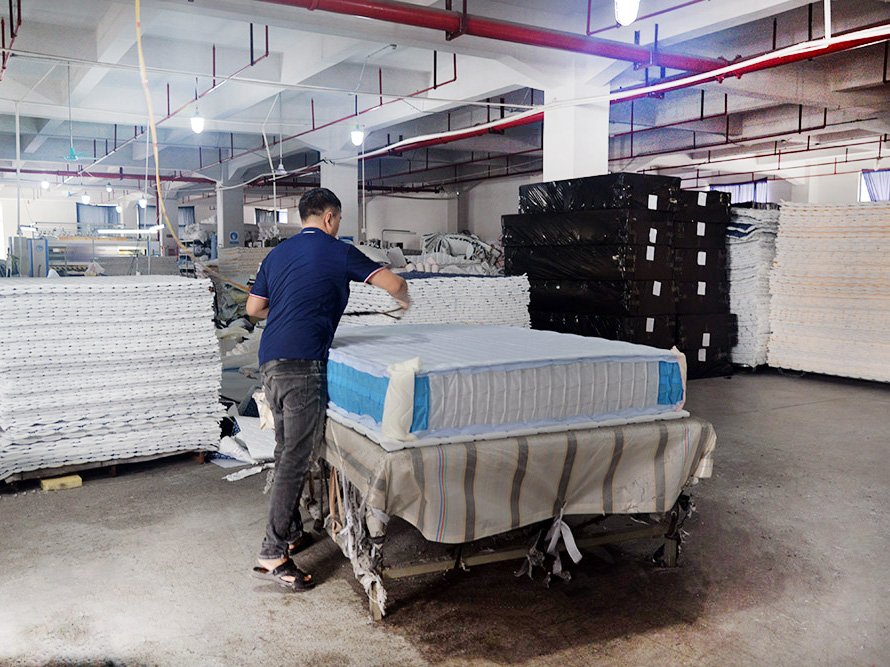The manufacturing of foam mattresses, particularly memory foam, is a venture that combines advanced chemical engineering with precise mechanical processes to meet increasing consumer demands for comfort and durability. At the core of production, the careful blending and expansion of polymers not only determine the feel and support of the final product but also its longevity and environmental footprint. As we explore the intricate steps from raw material selection to the final curing phase, one cannot help but ponder: how do these processes impact the overall quality and sustainability of the mattresses we sleep on every night?
Originating from NASA's space program in the 1960s, memory foam was developed to alleviate the intense pressure astronauts experienced during takeoff and reentry. Although NASA itself did not utilize this innovation in their spacecraft, recognizing its vast potential on Earth, they initiated a NASA partnership with Dynamic Systems to explore practical applications beyond aerospace.
This collaboration marked the beginning of the commercializing process, adapting the technology for use in medical and sports equipment, effectively meeting specific consumer demands in these sectors.
In the 1980s, the technology transitioned to private companies, spearheaded by Fagerdala World Foams. They were pivotal in refining the original formula and securing the rights to memory foam, setting the stage for broader commercial use. Fagerdala introduced the material into the consumer market with the launch of the Tempur-Pedic® mattress in 1991, which revolutionized sleep comfort and marked a significant milestone in memory foam's history.
This strategic move by Fagerdala exemplified the successful response to evolving consumer demands, demonstrating how private enterprise can leverage advanced technology initially designed for space exploration to create high-demand, everyday products. This evolution continues to shape the mattress industry, reflecting an ongoing commitment to innovation and consumer satisfaction.
A memory foam mattress is composed of several key materials including Relax Foam, Memory Foam, quilt fabric, thread, and cotton fabric roll. These components work synergistically to provide a balance of support and comfort, crucial for optimal sleep quality.
The structure of Memory Foam is particularly designed for pressure relief and support, adapting to the body's contours to reduce stress on pressure points and align the spine.
The benefits of such a mattress include enhanced comfort due to the softness of the foam, which allows for a personalized sleep experience. However, drawbacks exist; memory foam can retain heat, potentially leading to discomfort for some sleepers. Additionally, new mattresses might emit a distinct odor, a result of off-gassing from the manufacturing process.
In terms of durability, high-quality memory foam can withstand years of use while maintaining firmness and structural integrity. This longevity ensures continued support and comfort, making the investment in a memory foam mattress worthwhile for many consumers. Nonetheless, the initial firmness might adjust to increased softness over time, which can affect the overall sleep experience.
Balancing these elements is key to maximizing the benefits while minimizing any potential drawbacks.
The manufacturing process for memory foam mattresses involves several distinct steps, starting with the mixing of ingredients. This step is crucial as it determines the foam composition, influencing the final product's material properties such as density and firmness.
Following this, the mixture is whipped, introducing air and creating the signature viscoelastic texture of memory foam.
The next phase in the production process involves either infusion or vacuum sealing. This technique is vital for embedding additional materials that enhance the foam's comfort and support characteristics. Once the infusion is complete, the foam is allowed to cool and cure, a step that solidifies the structure and ensures durability.
Subsequent to curing, the foam undergoes a thorough washing to remove any residues, ensuring the product meets stringent quality control standards. The clean foam is then precisely cut into sheets that match the specific dimensions needed for mattress assembly.
The final step involves the careful assembly of the memory foam layers, adhering to detailed manufacturing techniques to maintain consistency and quality. Each layer is inspected and tested to ensure it meets the established criteria before the mattress is deemed ready for the market.
This rigorous control throughout the production process guarantees a product that offers superior comfort and longevity.
In foam mattress manufacturing, polyurethane foams are crafted through a chemical reaction involving polyisocyanate and polyol, facilitated by the presence of a blowing agent, a surfactant, and a catalyst. This process, which does not require external heating, relies on the exothermic nature of the reactions to drive foam molding and expansion. The result is a material that can be tailored to varying degrees of flexibility or rigidity, depending on the specific requirements of the mattress design.
The production method for polyurethane foam includes several critical stages:
These stages are carefully monitored to optimize the efficiency and quality of the final product, ensuring that each mattress provides the expected comfort, durability, and support.

Following the production phases of foam mattress manufacturing, testing for foam densities is paramount to ensure the product meets established quality and performance standards. This critical step assesses the foam's material composition, specifically regarding the presence of fillers like calcium carbonate, which are commonly used to increase the mass economically. However, these additives can affect the foam's ability to return to its original shape, a key indicator of quality.
Compression testing, such as the Indentation Force Deflection (IFD) Test, plays an essential role in this process. It measures how foam responds under a specific load, providing quantitative data on its resilience and durability. This test helps manufacturers ascertain whether the foam density aligns with rigorous manufacturing standards and if it can deliver the expected comfort and support over time.
Quality assurance teams meticulously analyze these results to ensure each batch of foam not only adheres to the internal benchmarks but also meets or exceeds industry expectations. Through rigorous testing, manufacturers can guarantee that the foam's density, a critical component of the mattress's overall performance and longevity, is consistent and reliable, safeguarding consumer satisfaction and trust.

How do manufacturers efficiently pack and ship voluminous foam mattresses to minimize storage and transportation costs? The key lies in advanced compression methods that reduce the mattress to a fraction of its original size, thus addressing transportation challenges effectively.
This process not only optimizes shipping logistics by allowing more products to be shipped at once but also reduces the environmental impact associated with larger shipments. The use of durable and flexible packaging materials ensures that despite the significant reduction in size, the integrity and quality of the mattress are preserved during transit, directly influencing customer satisfaction.
These materials are designed to withstand the rigors of transport while protecting the mattress from potential damage such as moisture and dirt.
To illustrate how these strategies are implemented, consider the following points:
These steps collectively ensure that the product reaches the consumer in excellent condition, ready for immediate use, and maintain high levels of satisfaction.
The foam mattress industry is experiencing significant growth, driven by increasing consumer awareness and rising incomes, particularly in markets like India where the organized sector's expansion is notable. The surge in market growth is also fueled by evolving consumer preferences, as modern buyers increasingly value products that cater to health and comfort, such as mattresses that reduce pressure points and minimize dust mites.
Industry innovations are continuously reshaping the landscape. Technological advancements are not only improving product quality—enhancing features like motion disruption prevention and support for various sleep positions—but are also streamlining manufacturing processes, making them more efficient and less costly. This strategic enhancement aligns with the growing demand, particularly in burgeoning economies with rising household numbers.
Furthermore, sustainability efforts are becoming a central focus within the industry. Manufacturers are increasingly adopting eco-friendly practices and materials, responding to consumer demand for greener products. This shift not only helps in reducing the environmental footprint but also positions brands as responsible and forward-thinking, appealing to a broader, more environmentally conscious consumer base.
These factors collectively suggest a robust future for the foam mattress industry, marked by continued expansion and innovation.
Yes, memory foam mattresses can cause allergic reactions. Accumulation of dust mites, mold spores, and shed skin cells can provoke symptoms, emphasizing the importance of bedroom hygiene for controlling these allergens.
To recycle a memory foam mattress, explore eco-friendly options that prioritize waste reduction and minimize environmental impact. Consider repurposing ideas or local recycling processes that dismantle the mattress for responsible material reuse.
While considering the suitability of memory foam mattresses for newborns, factors such as mattress firmness, infant safety, and the reduction of SIDS risk must be prioritized to ensure a safe sleep environment for infants.
Memory foam mattresses can emit VOCs due to off-gassing, raising health concerns and environmental impact. Ensuring compliance with safety regulations and rigorous product testing mitigates long-term effects and ensures comfort without compromising health.
A memory foam mattress, like a well-worn book, typically offers comfort for 7 to 10 years, depending on mattress durability, foam density, temperature regulation, foam compression, and comfort level.
In conclusion, the art of foam mattress manufacturing weaves together science and innovation like a meticulously crafted tapestry.
Each thread, from the intricate blending of materials to the precision of the curing process, fortifies the fabric of comfort and durability.
As the industry continues to expand, the horizons of mattress technology stretch even further, promising a future where every night's sleep is cradled in the arms of advanced, tailored comfort.
Shangrou Furniture Co., Ltd., established in 2011, is a leading mattress manufacturer specializing in diverse designs, including pocket springs and foam. With advanced technology and 100% OEM/ODM services, we provide high-quality, innovative mattresses for global brands, ensuring exceptional craftsmanship and long-term partnerships.
